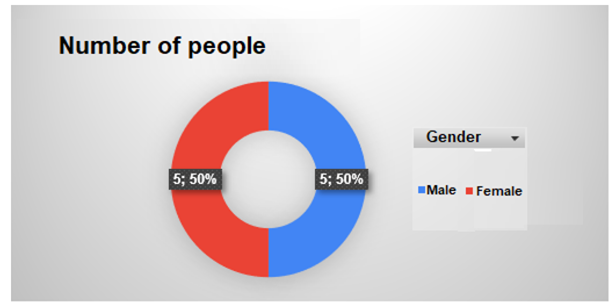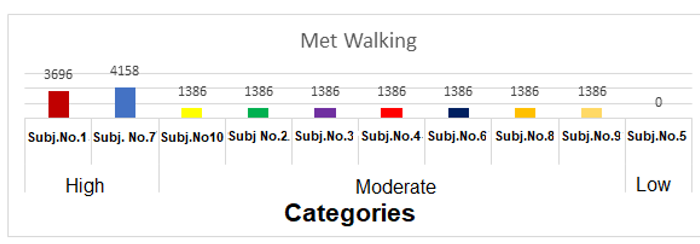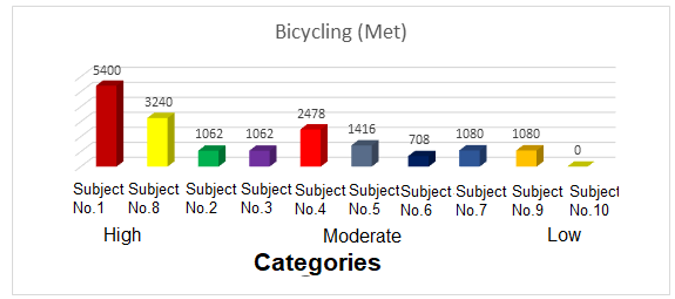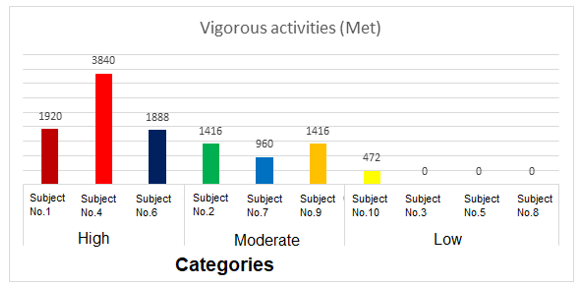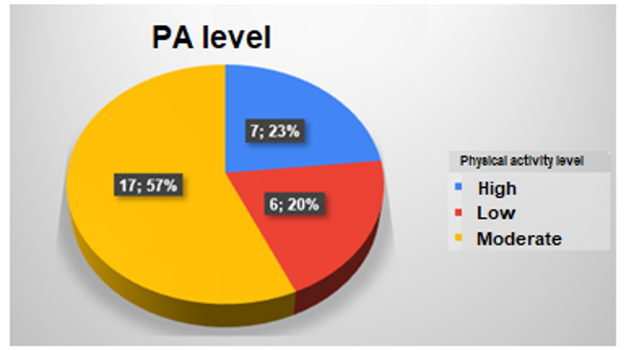Mi SciELO
Servicios Personalizados
Articulo
Indicadores
-
 Citado por SciELO
Citado por SciELO
Links relacionados
-
 Similares en
SciELO
Similares en
SciELO
Compartir
Ciencia y Deporte
versión On-line ISSN 2223-1773
Ciencia y Deporte vol.9 no.1 Camagüey ene.-abr. 2024 Epub 02-Abr-2024
http://dx.doi.org/10.34982/2223.1773.2024.v9.no1.002
Original article
Physical Activity Levels in University Students
1Corporacion Universitaria Minuto de Dios UNIMINUTO, Colombia.
Introduction:
In Colombia, several different studies have been done to determine the effect of physical activity on everyday life. A person's lifestyle upon entry to the university changes affects the habits, and physical and psychological health of a person.
Materials and methods:
Ten university students took part in the study, under an empirical and analytical approach based on a non-experimental method. The study conducted a short international questionnaire Physical Activity (IPAQ), and the Mets analysis technique.
Results:
More than 70 % of the students in the Physical Education bachelor's degree at the Minuto de Dios University Corporation UNIMINUTO had a moderate level of physical activity.
Conclusions:
Physical activity favors mental and physical health, prevents non-communicable diseases, enhances academic achievements and work performance, and increases social interaction, among others.
Key words: physical activity; health; lifestyle; academic achievement.
INTRODUCTION
Introduction: In Colombia, several different studies and plans have focused on determining the effect of physical activity on everyday life. Some programs produce assertive communication when sharing knowledge about the benefits of physical activity for the national population.
The scientific evidence shows that the benefits of regular physical activity (PA) are linked to physical and psychological aspects, which mean a reduction of an increasing number of chronic diseases, like diabetes mellitus, colon and mammary cancer, obesity, and hypertension (Garber et al., 2011). Besides, thanks to the reduction of risks, people enjoy more active lives and are healthy.
The prevention of obesity in children and adolescents occurs at critical ages when feeding habits develop, along with personal development and physical activity practice. The prevention of obesity in these years is critical; hence these ages have the greatest potential for change in education.
The current population has adopted a new nutritional culture that includes high-energy foods, lower fruit and vegetable consumption, and a trend stimulated by technology toward sedentary practices that reduce energy consumption (Collipal and Godoy, 2015).
Besides, physical activity is related to other elements, such as physical exercise and sports practice. In some cases, people who do not know about physical activity misunderstand its meaning and fail to identify their particular characteristics.
Balaguer and Castillo (cited in Acebes, 2019) said that the concept of PA comprises both physical exercise and sports. Usually, these three concepts are used indistinctly to refer to PA in general terms. However, when the objective is to make a specific analysis of the effects of each of these PA types, the term specific comes up.
Moreover, in reference to the significance of this activity in health, it is not about living free from diseases but becoming a person with a good sensation of well-being in every aspect of life, such as physical, psychological, and social well-being, which might help prevent diseases.
Physical activity is related to many beneficial factors for the lifestyle of people, especially if it is started in the early ages. Some studies of factors linked to physical activity focus on the belief, satisfaction, and motivation to exercise. Overall, the different attitudes toward physical activity show that the young have a positive belief, they feel they help improve health, prevent diseases, and improve moods (Varela et al., 2011; Bernate et al., 2020).
Furthermore, this type of activity influences the lifestyle of a person, both socially and personally. Lifestyle (LS) is defined by the World Health Organization as a general form of life based on the interaction between living conditions and individual patterns of behavior, determined by sociocultural factors and personal characteristics.
There is international concern about events derived from low physical activity in the youth, adults, and the elderly.
In 2016, 28 % of people over 18 were not sufficiently active in the world (23 % were men and 32 %, were women). It means that the global recommendations for moderate physical activity for at least 150 minutes a week, or hard physical activity for at least 75 minutes a week, were not followed (World Health Organization, 2020, par. 10).
Hence, a high percentage of people do not engage in fitness activities, which also means an increase in sedentary lifestyles and other conditions derived from the lack of physical activity. In the academic area, this factor can occur to a high percentage of students, both children and youngsters.
It is known that university students must split their time to cope with the amount of school-related activities, such as transportation, university, and free time. In this case, physical activity may be part of their free time, or become a new choice or activity.
In that sense, most university students verify that these new activities do not hurt their daily lives. In higher education, each student is required to know what activities can improve their academic performances and improve learning; and what factors must be thought of as enhancers if properly handled, such as time management.
University students should be interested in energy-consuming activities to strengthen their appearance, as described by Tylka (2012) . A positive body image is closely linked to psychological well-being; therefore, physical activity is a tool that provides satisfaction to people, especially among women. Besides, "It seems that the self-person concept is associated with significant factors like satisfaction in living" (Goñi et al., 2015).
Hence, a person's lifestyle upon entry to the university changes somehow, affecting the habits, and physical and psychological health of a person, and these changes come in different forms.
The behavior of university students must be understood, it depends on their personality, overall tastes, their leisure activities, with a great influence of technology, which is used daily for school things, the influence of close people, and the students' lifestyles.
Presently, technology has a tremendous influence as far as physical activity is concerned. According to Koezuka (cited in Ramos, Rivera, Moreno, and Jiménez-Iglesias, 2012), computer use is a relatively new sedentary type of activity among the young, and its relation to physical inactivity in adolescence must be studied.
Today, universities should be held as social referents in actions that improve public health in a community, as well as that of future professionals, through physical activity. Universities require the education of professionals in this regard, breaking with the trends of sedentary societies that promote obesity, and health conditions associated with the absence of physical activity in their lives (Llus, 2014).
Each university should invest in spaces that offer these leisure and physical activities due to the need to prove that for any type of activity performed (academic, work) there could be pauses where a different activity type could be performed.
Consequently, universities have acknowledged the necessity to offer spaces for PA with the participation of institutional sports groups, and intra and inter-university athletic competitions to orient how to use free time in physical activities (García et al., 2012, p.185).
Moreover, a percentage of students in universities suffer academic stress, which means that the body is responding in different ways, such as negative thoughts, fear, and cognitive anxiety; headaches, skin diseases, and physical muscle pain; and compulsive conduct at the motor level (Ávila, 2014).
Many university students experience stress. Stress is believed to trigger a series of diseases, namely central obesity, metabolic syndrome, and type 2 diabetes. It occurs due to the activation of hormones like adrenaline and norepinephrine. Cortisol is the potential ingestion of fats and high-caloric products that meet the energy requirement of the hypothalamus during severe stress, and an increase in hormonal action (Sarabdjitsing, Joëls & Kloet, 2012).
Likewise, Ramón et al. (2014) demonstrated that physical activity has a protective effect against stress. However, because of the limited amount of free time available throughout university life, academic overabundance is an issue that may affect the physical practice of certain students. A student is said to be free from academic stress if they manage their time and use strategies in a more organized way (Diaz, González, and Arrieta, 2014).
Besides knowing that PA is an important factor to counteract academic stress in university students, one element to be considered is the barrier created at the moment of deciding not to perform the activity. Why aren't they taken? What are the causes? How do these factors influence their participation in physical activities? Some of the individual factors cited by the scientific literature suggest that the identification of barriers to completing PA among university students must be one of the main priorities (Serrano et al., 2012).
In that sense, Ferreira et al. (2012) did several studies in university student populations and found that the barriers to MVPA are associated with MVPA levels (moderate or vigorous physical activity). This might be due to a change in the lifestyle that takes place in the transition between secondary and post-secondary education, such as residential changes, stress, lack of social support, an increase in recreational choices, etc. (Deliens et al., 2015).
A recent study in Spain found that the main barrier to adopting a more active lifestyle among university students was the lack of time (Martínez, Puig, and García, 2014). However, other studies have identified other factors (internal barriers) like the lack of interest, lack of usefulness or motivation, or feelings of laziness, apathy, or the perception of incompetence (Ashton, Hutchesson, Rollo, Morgan, & Collins, 2016; Daskapan, Tuzun, & Eker, 2006; Gómez, Granero, & Baena-Extremera, 2010). Accordingly, the aim of this research is to identify the current level of physical activity in university students.
MATERIALS AND METHODS
In this research, the quantitative and descriptive approaches were used to quantify the variables for the study. The quantitative paradigm leading to transversal aims to determine the level of physical activity in university students. Moreover, the supervision of academic performance and the physical activity level determine the meaning of the research in a social environment, since these problems occur institutionally.
Hence, the approach used was empirical-analytical and non-experimental. There was no group intervention, only the data from the students (voluntary collaborators) in the International Physical Activity Questionnaire (IPAQ).
Sample
The population comprised ten subjects (five women and five men), between ages 18-30, chosen selectively based on one criterion: a student of the sixth or seventh semester (2022-1) in the Physical Education Bachelor Program, the UNIMINUTO Minuto de Dios University Corporation.
The population and sample hypothesis was developed continuously; the total of university students nationally according to SNIES In 2020, this figure totalled 2 355 603 students, of which 715 675 were admitted that year in Bogota D.C. Hence, the sample of students from Bogota D.C. was 30.38 % (p.1)
The data were collected through the International Physical Activity Questionnaire (IPAQ), which has five areas, defined as physical activity related to transportation, work, home, chores, and garden (yard), free time use, and being seated. This questionnaire helped identify the number of days the subjects performed any of the activities located in the corresponding areas, along with the minutes or hours spent on it.
Accordingly, the technique Mets was used to analyze the results, which helped in the identification and interpretation of the results.
The volume of physical activity could be calculated by assessing or assigning each activity some energy requirements defined in Mets, to have the results in Mets-minutes. Mets are multiples of the rate of metabolic waste, and the Met-minutes would equal the multiplication of the results of Mets from one activity by the minutes in which it has been performed.
RESULTS AND DISCUSSION
Below are the figures showing the results and their interpretation (Figure 1).
This figure shows each subject's gender and their totals. Women and men have the same numbers (5 women and 5 men) (Figure 2).
The Met walking value was determined, with three PA levels (High, Moderate, and Low). Accordingly, the High category in subject No. 1 (3696 Met), and subject No. 7 (4158 Met) are in the same category; they have an equal number of 1386 Met and, therefore are within this category. The low category only included subject No. 5 with 0 Met.
Most subjects were in the Moderate category, with 600-3000 Met, followed by the High category. Besides, almost 95 % of students have a good walking level in their daily activities (Figure 3).
The third figure shows the Met value on bicycling moderately, with the value classified into three PA levels (High, Moderate, and Low). The High level shows Subject No. 1 with 5400 Met and subject No. 8 with 3240 Met. In the Moderate level are subjects No 2 and No 3 with 1062 Met, subject No 4 with 2478 Met, subject No 5 with 1416 Met, subject No 6 with 708 Met, and subjects No 7 and No 9 with 1080 Met. The low level shows subject No. 10 with 0 Met. The most relevant level was Moderate, as opposed to the Low.
Regarding the results, most students bicycle as a physical activity instead of using other means of transportation (Figure 4).
The fourth figure shows the Met value associated with vigorous activities, with the value classified into three PA levels (High, Moderate, and Low). The High level shows Subject No. 1 with 1920 Met, subject No. 4 with 3840 Met, and No 6 with 1888 Met. The Moderate level comprises subjects No 2 and No 9 with 1416 Met, and subject No 7 with 960 Met, and subjects No 3, No 5, and No 8 with 0 Met, whereas No 10 reached 472 Met The most relevant level was Low (4 subjects), while levels High and Moderate had the same number of subjects.
Figure 4 shows a change compared to the previous, with the Low above 40 % (no vigorous activity), which might perhaps be defined by the time spent on physical activity, school activities, and others. Moreover, 60 % was found in students who perform vigorous activities, whereas one subject showed a high level, possibly because he is a high-performance athlete (Figure 5).
The fifth and last column shows the level of physical activity corresponding to the total number regarding Met value; that is, the total number of PA as High, Moderate, and Low. Accordingly, the Moderate level was more relevant, with 57 %, followed by the High level (23 %), and the Low level (20 %).
More than 60 % of students perform physical activity between moderate and high, and this percentage is related to the time they spend on some kind of physical activity or sport. The study also found that most students are physically active while the rest are at a low level, mostly people who work and study at the same time, and have no time to perform any physical activity.
Considering the analyses of the results, it can be determined that Physical Education bachelors have a moderate level of physical activity, which is defined by the fact that they are physical activity promoters, physically active persons, who have an exemplary lifestyle.
Furthermore, the results also helped define that most participants are active, and through them, the study rejected the possibility that any of them were physically inactive. Hence, new questionnaires to determine the reasons why someone could not perform physical activity, are necessary.
The study identified the current level of university students, which facilitated the path this research had to follow, considering the steps to follow and how they should be taken.
The research concluded successfully, meeting all the objectives and providing researchers with a vision of how the Physical Education professionals are being trained.
One first question will help identify the pros and cons of the study. What were the strengths and weaknesses of the study?
Weaknesses: In the first part of the sample, the expected number of participants was not achieved. During the test, there was only one class ready to respond to the test. Perhaps, due to communicational reasons, the result would have been more relevant if the study had been done in other degrees where the low level of physical activity is evident, to learn the causes of that level and the factors that influenced the result.
Strength: The students in the Physical Education bachelor's degree may use any material and information related to physical education. This study found that the students were physically active, and it paved the way for further research to define concepts that could help determine why Physical Education Bachelors are physically active, while the students in other degrees are not. Having access to information about the benefits of physical activity is also important.
The aim of this research was to identify the level of physical activity in university students from the Physical Education Degree. Where the physical activity level is split into three levels: High, Moderate, and Low. The results showed that more than half of the students (five male and five female) have a moderate level of physical activity.
As stated by Hills et al (2015), (cited in Práxedes et al., 2016), these low PA levels are still more concerning during childhood, adolescence, and early adulthood, where healthy habits consolidate, and the design of strategies to decrease physical inactivity are required.
Some behaviors in these growing periods are fundamental since they determine the lifestyle of individuals, so they might be big influencers that lead the way for people who want to follow healthy lifestyles. Someone who starts exercising early will probably continue to do it in adulthood, either with the same physical activity or one similar.
Several behaviors like unhealthy eating habits, the lack of physical activity, drug use, smoking, alcohol, unhealthy sleeping, risky sexual conduct, and excess time in front of a screen have been acknowledged to contribute to reduced life quality. The previous behaviors prevail during the transition phases into early adulthood (Sánchez et al., 2019, p. 1).
Only 20 % of the students showed a low activity level, so the first assumption is that it influences the knowledge acquired in universities in terms of physical activity and its benefits. Besides, the students can access information, that maybe other students from different degrees cannot obtain, and that they are allowed to work on physical activity deeply.
The percentage of low physical activity, though not very influential, causes greater risks of suffering a non-communicable disease.
Martínez (2008) said,
"It is necessary to recognize the effects and risks of being sedentary as an significant factor in the occurrence of non-transmissible chronic diseases, their direct relation to diabetes, cancer, hypertension, obesity, and cardiovascular problems.
Moreover, a deeper analysis of the figures above showed that a low level of physical activity is only 0 (zero), perhaps because the questionnaires were not presented in a way that could provide information about the activity level, even when it was low.
Moreover, the high and moderate results in physical education may be explained in different ways, since the motivations of males to take physical education may be different from those of females. Mestek et al (cited in Fernández et al., 2015), noted that joy, social interaction, and competition are the main drivers for boys. In several research studies, females worry more about their appearance and its influence when they hang out with men. Other studies have pointed out the importance of the female image and the greater relevance of men in competition and social relations.
Not only that, some people do not care about the way they look in front of other people, but just the way they feel better. Marrodal et al (cited in Trejo et al. 2016) said that some authors point out that discomfort shows a different gender trend so while most women want to have a more stylish shape, men would look for more sturdiness.
Although the appearance and satisfaction with our bodies are important influential factors that play a role in the people's lifestyles.
Margarita et al. (2012):
"The importance of affective social work in the adoption of practical conduct of physical activity is shown in the results of this paper, which confirms low physical-sport practice during leisure is associated with the student's lack of social support from their parents to take physical activity and sports." (p.110)
Besides, some studies have shown that in the face of high physical activity in young adults, they feel they have the "capacity to develop any type of activity and enjoy daily activities. This is an encouraging element since the study comprises young subjects receiving education to collaborate with the development of the country" (Angelucci, Cañoto, and Hernández, 2017, p.539).
As evidence, Bernate and Fonseca (2022); and Casas and Castaño (2018) commented that in Bogota there are programs to perform physical activity and use their free time bicycling, the program Muevete Bogota, and take recreational activities. However, a considerable part of people ignore these tools due to their social dynamics and current habits. This is where this particular curricular project calls for the need to take responsibility for the low level of physical activity practice and use of tools provided by several institutions, with a significant role in the reduction of sedentary indexes.
Another aspect affected by the level of physical activity in the student is academic yields. Some studies have shown a marked difference between a person who takes physical activities and another who does not.
Mediavilla, Aldas, and Jarrín (2018):
"The universities rely on insufficient data to establish if the university student population takes physical activities included in the curriculum of face-to-face programs, so it may be an important factor affecting the academic performance of students, since the lack of activities may lead to overweight, obesity, hypertension, and diabetes." (p. 98)
Bringas, Rodríguez, and Herrero (cited in Sánchez et al., 2020) claimed that a student's academic performance may be affected by a variety of daily activities, including the utilization of several electronic means used for daily socializing.
These activities include spending time on social media sites, such as Facebook, X, and TikTok, and how much intelligence and responsibility they show when using them. Some studies have demonstrated that the utilization of these devices makes students spend more time on them, neglecting their academic side, which might cause lower yields in universities.
Consequently, if a university student leads a more active life, which includes physical activity, it can stimulate their academic side, producing remarkable improvements. As mentioned at the beginning of this study, physical activity contributes to reducing stress, favoring student performance in the self-set tasks as well as in those oriented in the curriculum.
In addition to academic performance, other areas are benefited as well; for instance, habits that make students desire to do their daily activities.
"It is important to collect information about physical activity habits in university students, since it is an ideal stage to strengthen good habits related to physical activity, such as nutrition and sleep, looking to ensure better physical and mental health. (p. 165)
Moreover, Enríquez et al. (2017), "Broadening the promotion of physical activity to encourage students to have a more favorable nutritional state, and study other factors that intervene in metabolic unbalance is advisable" (p. 65).
These habits are a clear example of how the lifestyles of university students change a great deal. In that sense, the habits acquired through physical activity include time, discipline, and management associated with daily activities, in addition to dedicating time for all the other more relevant activities.
CONCLUSIONS
This research has demonstrated the importance of physical activity, as stated by several authors, who support the idea that, even at an older age, its level of significance remains the same, and could even increase, accordingly. When youngsters start university, their lifestyles change in most cases, so a few aspects that used to be relevant for that person may not be now, or are, perhaps, more important.
University life influences the lifestyle of university students; many universities do not have the corresponding spaces to perform physical activity, leisure activities, or sports. Besides, workshops are critical so that students can integrate into groups of people and have healthy communication.
Lastly, physical activity favors mental and physical health, prevents non-communicable diseases, enhances academic achievements and work performance, and increases social interaction, among others. This is the time to start taking up physical activities. Families and friends should be encouraged, as well, along with the utilization of technology and bad habits.
REFERENCIAS BIBLIOGRÁFICAS
Angelucci, L. T., Cañoto, Y., & Hernández, M. J. (2017). Influencia del estilo de vida, el sexo, la edad y el míe sobre la salud física y psicológica en jóvenes universitarios. Avances en Psicología Latinoamericana, 35(3), 531-546. http://www.scielo.org.co/scielo.php?script=sci_arttext&pid=S1794-47242017000300531 [ Links ]
Ávila, J. (2014). El estrés un problema de salud del mundo actual. Revista CON-CIENCIA, 2(1), 117-125. http://www.scielo.org.bo/scielo.php?script=sci_abstract&pid=S2310-02652014000100013&lng=es&nrm=iso&tlng=es&lng=es [ Links ]
Bernate, J., & Fonseca, I. (2022). Formación de la Corporeidad hacia un Desarrollo Integral (Corporate training towards integral development). Retos, 43, 634-642. https://doi.org/10.47197/retos.v43i0.88804 [ Links ]
Bernate, J., Rincón Fonseca, E., & López Cruz, J. E. (2020). Sedentarismo y actividad física: Revisión bibliográfica de estrategias desde la educación física y aplicaciones prácticas para niños y adolescentes. EmásF: revista digital de educación física, 67, 137-156. https://dialnet.unirioja.es/servlet/articulo?codigo=7642868 [ Links ]
Chales-Aoun, A. G., Merino Escobar, J. M. (2019). ACTIVIDAD FÍSICA Y ALIMENTACIÓN EN ESTUDIANTES UNIVERSITARIOS CHILENOS. Ciencia y enfermería, 25, 0-0. https://doi.org/10.4067/s0717-95532019000100212 [ Links ]
Collipal, E., & Godoy, M. P. (2015). Representaciones sociales de la obesidad en jóvenes preuniversitarios y universitarios. International Journal of Morphology, 33(3), 877-882. https://www.scielo.cl/scielo.php?pid=S0717-95022015000300012&script=sci_arttext [ Links ]
Enríquez-del Castillo, L. A., León-Fierro, L. G. D., Marcos-Pardo, P. J., Martinez-Rodriguez, A., Candia-Luján, R., & Carrasco-Legleu, C. E. (2017). Actividad física, ingesta alimentaria e indicadores antropométricos en estudiantes universitarios. Tecnociencia. 11(2). https://rua.ua.es/dspace/bitstream/10045/93909/1/2017_Enriquez_etal_Tecnociencia -Chihuahua.pdf [ Links ]
Fernández Ozcorta, E. J., Sáenz López Buñuel, P., Almagro, B. J., & Conde García, C. (2015). Motivos de práctica de actividad física en universitarios activos. EmásF, Revista Digital de Educación Física. 6(34). https://emasf.webcindario.com/Motivos_de_practica_de_actividad_fisica_en_universitarios_activos.pdf [ Links ]
Garber CE, Blissmer B, Deschenes MR, et al. (2011) American College of Sports Medicine position stand. Quantity and quality of exercise for developing and maintaining cardiorespiratory, musculoskeletal, and neuromotor fitness in apparently healthy adults: Guidance for prescribing exercise. Med Sci Sport Exerc.; 43(7):1334-59. DOI: https://doi.org/10.1249/MSS.0b013e318213fefb [ Links ]
García-Laguna, D.G., García-Salamanca, G. P., Tapiero-Paipa, Y. T., & Ramos C., D. Marcela. (2012). Determinantes de los estilos de vida y su implicación en la salud de Jóvenes universitarios. Hacia la Promoción de la Salud, 17(2), ISSN: 0121-7577. https://revistasojs.ucaldas.edu.co/index.php/hacialapromociondelasalud/article/view/2041 [ Links ]
Goñi Palacios, E., Esnaola Echaniz, I., Rodríguez Fernández, A., & Camino Ortiz de Barrón, I. (2015). Personal self-concept and satisfaction with life in adolescence, youth and adulthood. Psicothema, 27(1), 52-58. https://ibecs.isciii.es/cgi-bin/wxislind.exe/iah/online/?IsisScript=iah/iah.xis&src=google&base=IBECS&lang=e&nextAction=lnk&exprSearch=132029&indexSearch=ID [ Links ]
Díaz Llus, A. (2014). La práctica de la actividad física en estudiantes universitarios. Athlos: Revista internacional de ciencias sociales de la actividad física, el juego y el deporte, 7, 28-44. https://dialnet.unirioja.es/servlet/articulo?codigo=5314797 [ Links ]
Martínez, B. J. S. A., Sánchez-Díaz, A., Alfonso-Asencio, M., Courel-Ibáñez, J., & Sánchez-Pay, A. (2020). Relación entre el nivel de actividad física, uso de videojuegos y rendimiento académico en estudiantes universitarios. Espiral. Cuadernos del profesorado, 13(26), 64-73. https://ojs.ual.es/ojs/index.php/ESPIRAL/article/view/2900 [ Links ]
Mediavilla, C. M. Á., Arcos, H. G. A., & Jarrín, S. A. (2018). La actividad física y el rendimiento académico en estudiantes universitarios. Killkana sociales: Revista de Investigación Científica, 2(4), 97-102. https://dialnet.unirioja.es/descarga/articulo/6799307.pdf [ Links ]
Moreno-Arrebola, R., Fernández-Revelles, A., Linares Manrique, M., & Espejo, T. (2018). Revisión sistemática sobre hábitos de actividad física en estudiantes universitarios. Sportis, 4(1), 162-183. https://ruc.udc.es/dspace/bitstream/handle/2183/22807/REV+-+SPORTIS_+2018_4 -1_art_11.pdf?sequence=3 [ Links ]
Organización Mundial De La Salud. (2020). Actividad física. OMS. https://www.who.int/es/news-room/fact-sheets/detail/physical-activity [ Links ]
Ostos, L. M. (2008). Condición física y nivel de actividad física en estudiantes universitarios. Teoría y praxis investigativa, 3(1), 21-28. https://dialnet.unirioja.es/descarga/articulo/3701051.pdf [ Links ]
Práxedes, A., Moreno, A., Sevil, J., Del Villar, F., & García-González, L. (2016). Niveles de actividad física en estudiantes universitarios: diferencias en función del género, la edad y los estados de cambio. Revista Iberoamericana de Psicología del Ejercicio y el Deporte. 11(1), 123-132. https://www.redalyc.org/pdf/3111/311143051014.pdf [ Links ]
Ramón Suárez, G., Zapata Vidales, S., & Cardona-Arias, J. (2014). Estrés laboral y actividad física en empleados. Diversitas: Perspectivas en Psicología, 10(1), 131-141. http://www.scielo.org.co/scielo.php?script=sci_arttext&pid=S1794-99982014000100010&lng=en&tlng=es. [ Links ]
Ramos Valverde, P., Rivera de los Santos, F. J., Jiménez Iglesias, A. M., & Moreno Rodríguez, M. D. C. (2012). Análisis de clúster de la actividad física y las conductas sedentarias de los adolescentes españoles, correlación con la salud biopsicosocial. Revista de Psicología Del Deporte, 21 (1), 99-106. https://idus.us.es/bitstream/handle/11441/23184/file_1.pdf?sequence=1 [ Links ]
Sánchez-Guette, L., Herazo-Beltrán, Y., Galeano-Muñoz, L., Romero-Leiva, K., Guerrero-Correa, F., Mancilla-González, G., & Pino, L. O. (2019). Comportamiento sedentario en estudiantes universitario. Revista Latinoamericana de Hipertensión, 14(4), 393-397. https://www.redalyc.org/journal/1702/17026 3002004/html/ [ Links ]
Sarabdjitsingh, R. A., Joëls, M., & De Kloet, E. R. (2012). Glucocorticoid pulsatility and rapid corticosteroid actions in the central stress response. Physiology & behavior, 106(1), 73-80. http://www.doi.org/10.1016/j.physbeh.2011.09.017. [ Links ]
Trejo-Ortíz, P. M., Mollinedo Montaño, F. E., Araujo Espino, R., Valdez-Esparza, G., & Sánchez Bonilla, M. (2016). Hábitos de actividad física y cánones de imagen corporal en estudiantes universitarios. Revista Cubana de Medicina General Integral, 32(1), 0-0. http://scielo.sld.cu/scielo.php?pid=S0864-21252016000100010&script=sci_arttext&tlng=en [ Links ]
Tylka, T. (2012). Perspectivas feministas sobre la imagen corporal. Imagen corporal. Un manual de ciencia, práctica y prevención (pp. 56-66). Nueva York: Guilford Press. [ Links ]
Varela, M. T., Duarte, C., Salazar, I. C., Lema, L. F., & Tamayo, J. A. (2011). Actividad física y sedentarismo en jóvenes universitarios de Colombia: prácticas, motivos y recursos para realizarlas. Colombia médica, 42(3), 269-277. http://www.scielo.org.co/scielo.php?script=sci_arttext&pid=S1657-95342011000300002 [ Links ]
Received: September 04, 2023; Accepted: October 24, 2023











 texto en
texto en 

